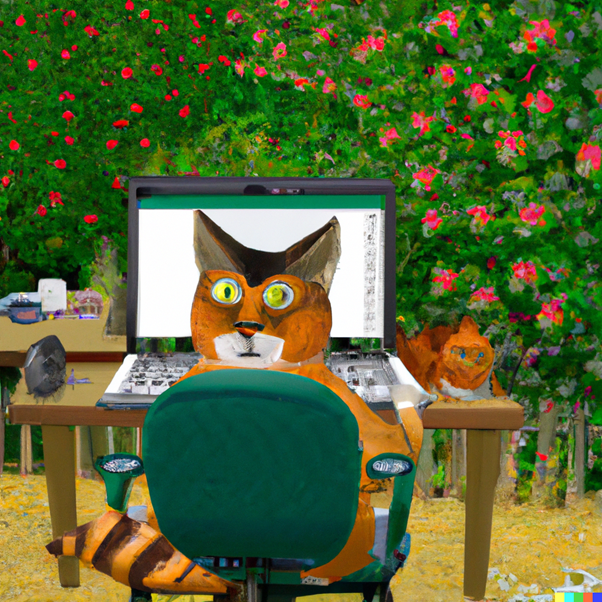
Games developer Jason M. Allen recently won an art competition in Colorado. However, the artistic genius behind the work was not him, but artificial intelligence: His piece, “Théâtre D’opéra Spatial”, was created using an AI software named “Midjourney”. Needless to say this caused huge controversy in the art world and beyond.
With his successful entry, another boundary has been crossed in the battle between man and machine, similar to what happened in 1996 when chess champion Kasparov lost against an algorithm, or a little more recently, when a Go master was beaten by a computer.
A few weeks ago, another AI tool named DALL-E, was made available to the public. It has the uncanny ability to turn text instructions into pictures and is said to be the most advanced AI art generator yet. OpenAI, the Silicon Valley research lab behind the program, announced recently that it has dropped the waitlist to use the program. Reading about this, stirred my curiosity, and I could not resist registering for a trial.
The instructions are terribly simple. You have to give the program a “prompt”, i.e. a description of the subject of your painting, Optionally, you also tell it what painting style you wish to apply, perhaps “Rembrandt”, or “Picasso”, or “Grosz”, or “Black and White”, or “Foggy”. Clearly, depending on how detailed, how weird, or how simplistic your description is, you may get surprising results, or disappointing ones. But whatever, I think it is truly AMAZING. And of course you can experiment to your heart’s content, and you can upload existing paintings, or photographs, and get those enhanced, romanticized, or whatever you fancy.
The guide to the software makes it clear that even the creators of DALL·E 2 don’t know what the tool knows and doesn’t know. Instead, users have to work out what it’s capable of doing and how to get it to do what they want.
As you can image, many creatives are concerned about what AI image generators mean for the future of their jobs. I presume that just like Google Translate or DeepL it shouldn’t be putting any artists out of work, but rather that there may be potential for creatives to make the tool work for them by opening up innovative possibilities, and accelerating things. Think of all the games developers who often have to produce artwork in a very limited timeframe. Clearly, this could be of great benefit for artists – just like MT for us translators.
And just like Machine Translation does not “understand meaning”, DALL-E doesn’t actually “know” or “understand” what it’s creating. Instead, it makes assumptions based on the massive database of 650 million images, assembling elements that it’s already been fed.
How do you use Dall-E? It is incredibly simple (otherwise I would have not succeeded). You just type your instruction into a text field. This is called a “prompt”, for example “A giraffe waiting at the traffic lights at Piccadilly Circus in the snow, wearing goggles, while 4 policemen watch in disbelief.” It seems the AI generator has no inhibitions and excels at “translating” the most far-fetched and outlandish instructions into pure magic or apocalyptic imagery.
The prompt I chose for my initial exercise was: “A tabby cat sitting on a chair in the garden typing on a computer keyboard, with a bushy-tailed fox watching, in the style of XXX” (where XXX was Klimt, Van Gogh, Picasso, Liebermann, etc.).
You can see some of the results below. I must admit, I found the whole experience totally addictive! By now of course I have forgotten my password, so I won’t be able to get back into it. And clearly, I have to stop, since there is work to do.
Amazingly, I read that the AI generator finds picturesque representations even for abstract concepts, such as belief, hope, time, etc. It seems that nothing is too outlandish, too far-fetched, too concrete or too abstract. Its only boundaries are pornography, brutality, etc.
So, is this the true democratization of art, and the end of the original genius? Well, just like MT, the machine relies on human input. In the first instance, it is you, the human, who has to come up with a prompt, and initiates the whole “creative process”, and then the machine kicks in, using a vast repository of paintings, drawings, photographs, making associations (“networking”) to assemble something new. It is not art as we have understood it hitherto. There is no authenticity, no autonomy, no self-reflection. It is not the “individual” that counts, it is (wo)mankind with all our artistic tradition and magination, plus the application of stylistic rules. It is a kind of collective art that evens things out. Very similar to what we are seeing as the effect of MT: ironing out the individual writer’s or translator’s style and producing something more generic, less idiosyncratic.
It does lead me to think that we are not such a long way away from being able to add a “prompt” to our MT engines: “Translate this in the style of the Apple marketing team”, or “… in the style of a Grimm’s fairy tale”.
To start with, try identifying Picasso, Liebermann, Van Gogh, etc.
Some interesting links:
https://www.creativebloq.com/news/how-to-use-dall-e
https://www.nytimes.com/2022/09/02/technology/ai-artificial-intelligence-artists.html; https://the-decoder.com/openai-dall-e-2-prompt-guide-how-to-control-image-generation/;https://dallery.gallery/dall-e-ai-guide-faq/






Click button bellow to apply to work as a freelancer.
Apply as a freelancer